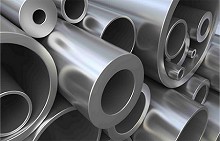
Grade 304 is the standard "18/8" stainless; it is the most versatile and most widely used stainless steel, available in a wider range of products, forms and finishes than any other. It has excellent forming and welding characteristics. The balanced austenitic structure of Grade 304 enables it to be severely deep drawn without intermediate annealing, which has made this grade dominant in the manufacture of drawn stainless parts such as sinks, hollow-ware and saucepans. For these applications it is common to use special "304DDQ" (Deep Drawing Quality) variants. Grade 304 is readily brake or roll formed into a variety of components for applications in the industrial, architectural, and transportation fields. Grade 304 also has outstanding welding characteristics. Post-weld annealing is not required when welding thin sections.
Grade 304L, the low carbon version of 304, does not require post-weld annealing and so is extensively used in heavy gauge components (over about 6mm). Grade 304H with its higher carbon content finds application at elevated temperatures. The austenitic structure also gives these grades excellent toughness, even down to cryogenic temperatures.
Possible Alternative Grades
Table 5. Possible alternative grades to 304 grade stainless steel
|
Grade |
Why it might be chosen instead of 304 |
|
301L |
A higher work hardening rate grade is required for certain roll formed or stretch formed components. |
|
302HQ |
Lower work hardening rate is needed for cold forging of screws, bolts and rivets. |
|
303 |
Higher machinability needed, and the lower corrosion resistance, formability and weldability are acceptable. |
|
316 |
Higher resistance to pitting and crevice corrosion is required, in chloride environments |
|
321 |
Better resistance to temperatures of around 600-900°C is needed…321 has higher hot strength. |
|
3CR12 |
A lower cost is required, and the reduced corrosion resistance and resulting discolouration are acceptable. |
|
430 |
A lower cost is required, and the reduced corrosion resistance and fabrication characteristics are cceptable. |
Corrosion Resistance
Excellent in a wide range of atmospheric environments and many corrosive media. Subject to pitting and crevice corrosion in warm chloride environments, and to stress corrosion cracking above about 60°C. Considered resistant to potable water with up to about 200mg/L chlorides at ambient temperatures, reducing to about 150mg/L at 60°C.Heat Resistance
Good oxidation resistance in intermittent service to 870°C and in continuous service to 925°C. Continuous use of 304 in the 425-860°C range is not recommended if subsequent aqueous corrosion resistance is important. Grade 304L is more resistant to carbide precipitation and can be heated into the above temperature range.Grade 304H has higher strength at elevated temperatures so is often used for structural and pressure-containing applications at temperatures above about 500°C and up to about 800°C. 304H will become sensitised in the temperature range of 425-860°C; this is not a problem for high temperature applications, but will result in reduced aqueous corrosion resistance.
Typical applications include:
- Food processing equipment, particularly in beer brewing, milk processing & wine making.
- Kitchen benches, sinks, troughs, equipment and appliances
- Architectural panelling, railings & trim
- Chemical containers, including for transport
- Heat Exchangers
- Woven or welded screens for mining, quarrying & water filtration
- Threaded fasteners
- Springs
